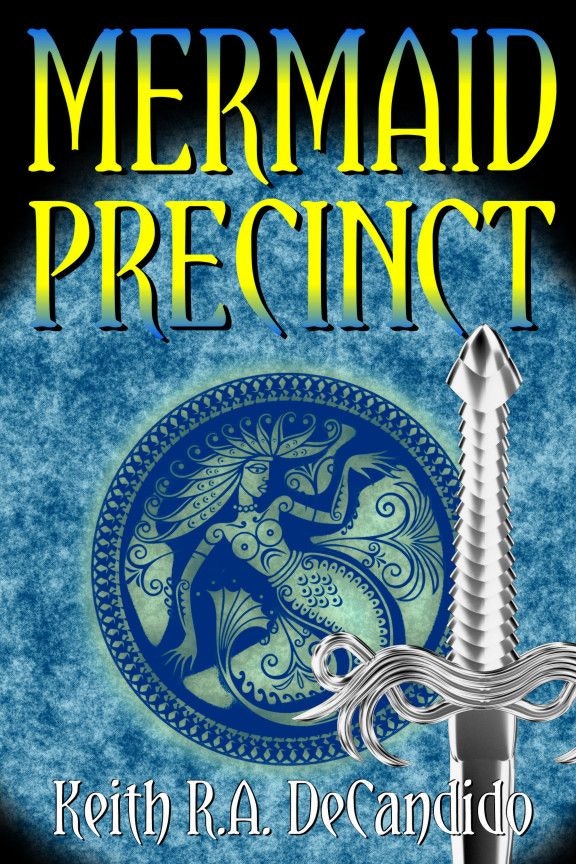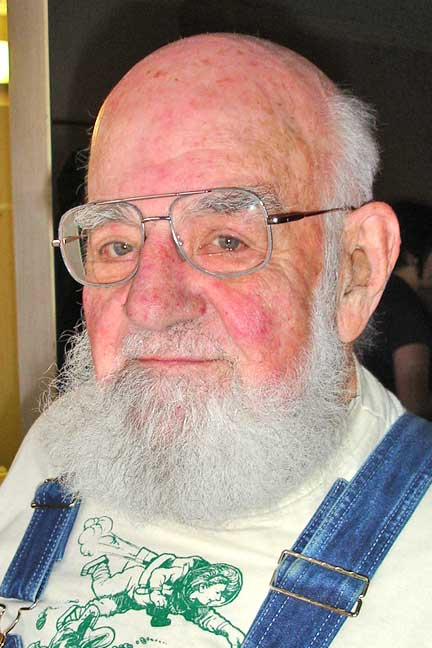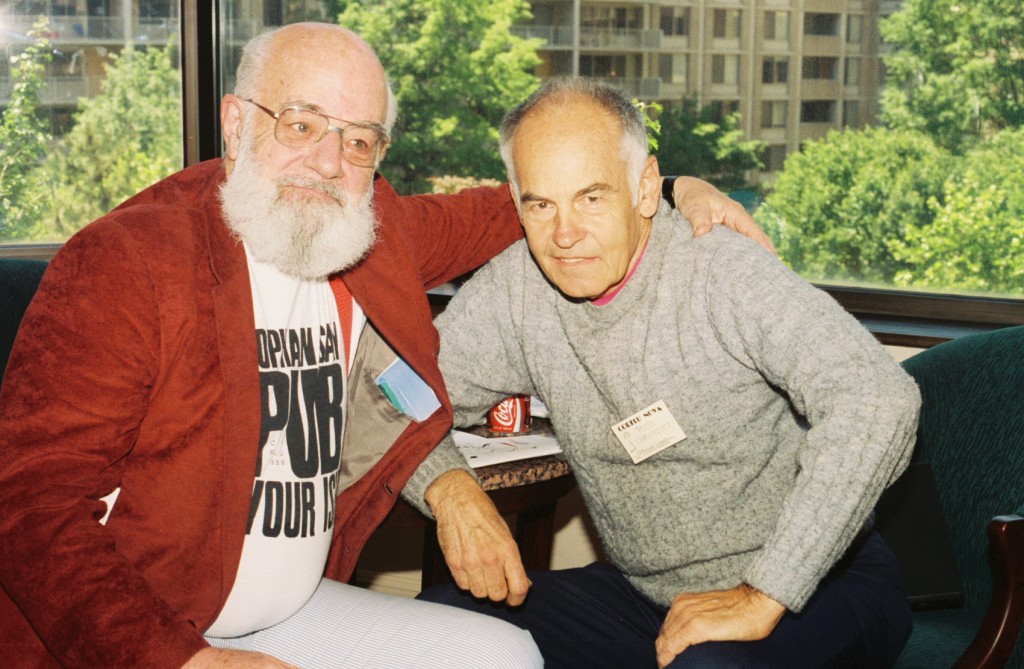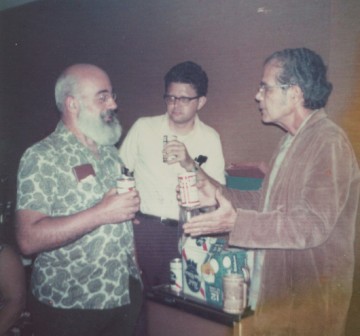(1) A NICE ROUND NUMBER. Air New Zealand just might take up George R.R. Martin’s suggestion to fly a bunch of his fans to next year’s Worldcon, CoNZealand.
(2) CONZEALAND. Here’s an interview with the 2020 Worldcon chair recorded not long ago, but before the events in the first item.
We are back with our video coverage from Wellygeddon 2019, this time we talked to Norman, one of the awesome people behind CoNZealand, the 78th World Science Fiction Convention, which is happening on 29th July – 2nd August 2020, and they are looking for volunteers!
(3) NO CHESSIECON THIS YEAR. Chessiecon 2019 has been cancelled. The convention had been planned for November 29-December 1, 2019 in Baltimore. Refunds are promised. The committee says the con will return in 2020. Chair Joshua Kronengold explained:
None of us wanted this outcome. However, lack of responsiveness from the hotel, combined with information from current and former staff about its current state, has led us inexorably to a lack of confidence that the Red Lion is capable of hosting a convention to our standards. This hotel has been used by first Darkover since 1988 and Chessiecon from the start, but over the years we have received an increasing number of complaints about it, and this year the problems have become untenable. The committee discussed the options in considerable depth before reaching this decision, but see no way to continue for 2019 without sacrificing the quality of our convention. We decided it would be more productive to focus our energies on future years….
(4) THEY’LL BE BACK. Terminator: Dark Fate comes to theatres November 1, 2019.
Welcome to the day after Judgment Day. …Linda Hamilton (“Sarah Connor”) and Arnold Schwarzenegger (“T-800”) return in their iconic roles in Terminator: Dark Fate, directed by Tim Miller (Deadpool) and produced by visionary filmmaker James Cameron and David Ellison. …Also stars Mackenzie Davis, Natalia Reyes, Gabriel Luna, and Diego Boneta.
(5) NEXT KGB. Fantastic Fiction at KGB reading series hosts Ellen Datlow and Matthew Kressel present Chuck Wendig and Keith R.A. DeCandido on Wednesday, June 19th.
Chuck Wendig

Chuck Wendig is the New York Times bestselling author of Star Wars: Aftermath, as well as the Miriam Black thrillers, the Atlanta Burns books, Zer0es/Invasive, and Wanderers coming in July 2019. He’s also written comics, games, film, and more. He was a finalist for the John W. Campbell Award for Best New Writer, an alum of the Sundance Screenwriters Lab, and served as the cowriter of the Emmy-nominated digital narrative Collapsus. He is also known for his popular blog, terribleminds.com, and books about writing such as Damn Fine Story. He lives in Pennsylvania with his family.
Keith R.A. DeCandido

Keith R.A. DeCandido is celebrating the 25th anniversary of his fiction writing career. His media tie-in fiction — which earned him a Lifetime Achievement Award in 2009 — covers 33 different universes, from Alien to Zorro. His original work includes stories set in the fictional cities of Cliff’s End and Super City, as well as the somewhat real locales of New York and Key West. His 2019 novels include Mermaid Precinct, the latest in his fantasy police procedural series; Alien: Isolation, based on the classic movie series; and A Furnace Sealed, launching a new urban fantasy series taking place in the Bronx, where Keith currently lives with assorted humans and felines.
The event takes place Wednesday, June 19, starting 7 p.m. at KGB Bar, 85 East 4th Street (just off 2nd Ave, upstairs), New York, NY
(6) DOLLARS AND SENSE. Patch O’Furr winds up a three-part series in “How furries resist a commercialized fandom (Part 3)”.
… “Resistance” can mean something unintentional, like friction. It doesn’t necessarily mean a deliberate anti-commercial mission. At the roots of fandom, noncommercialism probably meant doing DIY things the mainstream wasn’t doing. Now, when some furries make a living from business with other fans, you can call it organically indie. That’s not exactly a coordinated alternative, like socialistic co-ops….
How commercialism creeps in and complicates the fandom: There’s an exchange when fandom had roots in the mainstream, built an alternative place, and then influences the mainstream back. To win over fans as consumers, outsiders might tiptoe up to a line between respectable and weird, but not cross it. They may get resistance while the line protects independence. In fandom or out, engaging can be shaky for projects that need serious support (like a movie that needs a budget to get made right.) Worthy projects can fail because you can’t please all the people all of the time. Others can succeed by pleasing people while scamming or exploiting the base that made it possible.
If furry is commercializing, it can be seen in success of furry game devs, Youtubers, or Esports stars (like SonicFox). On the outside, furries show up in commercials/ads and music videos of non-indie artists. Psuedo-fursuits at Walmart or cheap knockoffs at DHGate may rise closer to fandom quality….
(7) AMONG THE STARS. The Harvard University Press does a “Q&A with Jo Dunkley, author of Our Universe: An Astronomer’s Guide”, which includes a shout-out to a Dublin 2019 guest of honor:

The book features many of the great names we would expect to see—the Galileos and Einsteins—but you also draw attention to unheralded and underappreciated astronomers, many of them women. Is it fair to say that some of the lost remarkable work done over the past 100 years has been done by women, either as individuals or in teams, like the Harvard Computers?
They have had a huge impact. The Harvard Computers in the early twentieth century, including Annie Jump Cannon, Henrietta Swan Leavitt, and later Cecilia Payne-Gaposchkin, were responsible for making sense of the different types of stars, understanding how to measure vast distances in the universe, and figuring out what stars are actually made of. Other pioneering women include Vera Rubin, who solidified the evidence for invisible dark matter, and Jocelyn Bell Burnell. She discovered an entirely new type of spinning star that is so dense that a teaspoonful would weigh as much as a mountain.
(8) FANAC FOR THE MASSES. SF fan Louis Russell Chauvenet coined the word “fanzine” in 1940. It has since permeated popular culture – witness the LA Zine Fest (happening May 26) which encourages people “make a fanzine about a band, artist, activist, organizer, writer…anyone who inspires you!”
(9) TODAY’S BIRTHDAYS.
[Compiled by Cat Eldridge.]
- Born May 23, 1921 — James Blish. What was his best work? Cities in Flight? A Case of Conscience? I’d argue it was one of those works. Certainly it wasn’t the Trek novels though he pumped them out — nearly ninety all told if I’m reading ISFDB right. And I hadn’t realized that he wrote one series, the Pantropy series, under a pen name (Arthur Merlyn). (Died 1975.)
- Born May 23, 1933 — Joan Collins, 86. Edith Keeler in the “City of the Edge of Forever” episode — initial script by Harlan Ellison with rewrites by Gene Roddenberry, Steven W. Carabatsos and D. C. Fontana. I see she’s done a fair amount of other genre work including being Baroness Bibi De Chasseur / Rosy Shlagenheimer in the “The Galatea Affair” of The Man from U.N.C.L.E. and The Siren Lorelei in the “Ring Around the Riddler” and “The Wail of the Siren” episodes of Batman.
- Born May 23, 1933 — Margaret Aldiss. Wife of Brian Aldiss. She wrote extensively on her husband’s work including The Work of Brian W. Aldiss: An Annotated Bibliography & Guide. He in turn wrote When the Feast is Finished: Reflections on Terminal Illness, a look at her final days. She also co-edited the A is for Brian anthology with Malcolm Edwards and Frank Hatherley. (Died 1997.)
- Born May 23, 1935 — Susan Cooper, 84. Author of the superb Dark is Rising series. Her Scottish castle set YA Boggart series is lighter in tone and just plain fun. I’d also recommend Dreams and Wishes: Essays on Writing for Children which is quite excellent.
- Born May 23, 1979 — Brian James Freeman, 40. Horror author. Novels to date are Blue November Storms, This Painted Darkness and Black Fire (as James Kidman). He’s also done The Illustrated Stephen King Trivia Book which he co-authored with Bev Vincent and which is illustrated by Glenn Chadbourne. He publishes limited edition books here.
- Born May 23, 1986 — Ryan Coogler, 33. Co-writer with Joe Robert Cole of Black Panther which he also directed, as he will Black Panther 2. Producer, Space Jam 2 (pre-production)
(10) COMICS SECTION.
- Brevity comes up with another delightfully dreadful Game of Thrones-themed pun.
(11) THE GODFATHER MEETS THE FAIRY GODMOTHER. The way Steph Post sees it, “Fairy Tales Are Really Just Hard-Boiled Crime Stories” – at CrimeReads.
…Modern crime fiction has nothing on the ingenuity, brutality and sheer bizarreness of the offenses committed in classic fairy tales. Moreover, fairy tales are ruthless. Our contemporary crime novels have the monopoly on moral ambiguity, true, but fairy tales take no prisoners and often offer no redemption. Mercy is not a hallmark of the genre and even the kindest, most benevolent maid-turned-princess isn’t afraid to take out her wicked stepmother.
(12) SYMBOLS OF THE RENAISSANCE. Mlex writes, “I recently had an opportunity to interview Prof. Arielle Saiber, author of Measured Words.” Hear what they had to say in this podcast — “On Measured Words: Computation and Writing in Renaissance Italy”.
A conversation with Arielle Saiber, Professor of Romance Languages at Bowdoin College. Covering topics that range from hallucinatory landscapes to Dante’s primum mobile, our conversation touched on the quest for harmony between the computational aspects of math and the physical aspects of writing, printing, and typography. Based on the lives of four scholars who lived during the Italian Renaissance, we explore their use of symbols and codes, their modes of teaching and expression, and the interdisciplinary nature of their work.
(13) THE SOUND OF ONE HAND CLAPPING. At Death Is Bad, Eneasz Brodski explains his reasons for thinking the “Final Episode of Game of Thrones was kinda good, in a way”.
…But when you take it all together–the amazing series, the precipitous decline, and the absolute travesty of Season Eight… it final episode comes through as a good mood piece. This episode was the final death rattle of a show we once loved. It was a funeral for vision and beauty. Everything was dark and dreary and awful, and even the sunny day at the end was basically a spiteful sun-god laughing at all men’s follies; rather than cheerful.
(14) CUTTING OUT THE MIDDLE (AND EVERY OTHER) MAN. This robotic delivery concept is making news today:
Ford is teaming up with Agility Robotics to explore how the company’s new robot, Digit, can help get packages to your door efficiently with the help of self-driving vehicles. Not only does Digit work collaboratively with self-driving vehicles, but it can also walk up stairs and past unexpected obstacles to get packages straight to your doorstep.
(15) EXECUTIVE CREDENTIALS. BBC recalls “The cat who saved a Japanese rail line”.
Not only did Tama’s sweet nature and photogenic features make her popular with commuters on the Kishigawa railway, but the ‘cat master’ became so famous she was knighted.
On a bright May morning at Japan’s Idakiso train station, a small cat basked in the sun as her photo was taken by a group of tourists before getting a tummy tickle from a toddler. While the white, tan and black kitten purred and meowed in the arms of a visitor, one of the station workers looked on with a grin, interjecting only to gently reposition the cat’s brimmed conductor hat whenever it threatened to slip over her eyes.
“Having her around the station makes everyone happy,” he said, as the cat playfully swiped at a tourist’s iPhone. “I sometimes forget that she is my boss.”
Meet Yontama, the latest in a line of feline stationmasters that has helped save the Kishigawa railway line in Japan’s Wakayama prefecture, a largely mountainous and rural part of the country famous for temple-studded hillsides and sacred pilgrimage trails.
This story began in the late 1990s with a young calico cat called Tama. The kitten lived near Kishi Station – the final of 14 stops on a 14.3km line that connects small communities to Wakayama City, the region’s hub – and would frequently hang out by the railway, soaking up affection from commuters.
(16) A MOST ROBORATIVE BEVERAGE. Archeologists anticipated two possible outcomes when they did this — “Israeli researchers brew ‘ancient beer’ with antique yeast”.
Israeli researchers have unveiled a “breakthrough” beer made from ancient yeast up to 5,000 years old.
Researchers from the Antiquities Authority and three Israeli universities extracted six strains of the yeast from old pottery discovered in the Holy Land.
It is believed to be similar to beverages enjoyed by the Pharaohs of ancient Egypt.
The team said it hoped to make the drink available in shops one day.
“I remember that when we first brought out the beer we sat around the table and drank… and I said either we’ll be good or we’ll all be dead in five minutes,” said Aren Maeir, an archaeologist with Bar-Ilan University. “We lived to tell the story”.
(17) VIDEO OF THE DAY. In Anvil on Vimeo, Geriko tells about a young woman downloading her brain in preparations for the afterlife.
[Thanks to Daniel Dern, Andrew, Keith Lynch, Chip Hitchcock, John King Tarpinian, Cat Eldridge JJ, Mike Kennedy, Martin Morse Wooster, Mlex, Michael Toman, Andrew Porter, and Carl Slaughter for some of these stories. Title credit goes to File 770 contributing editor of the day Robert Whitaker Sirignano.]







